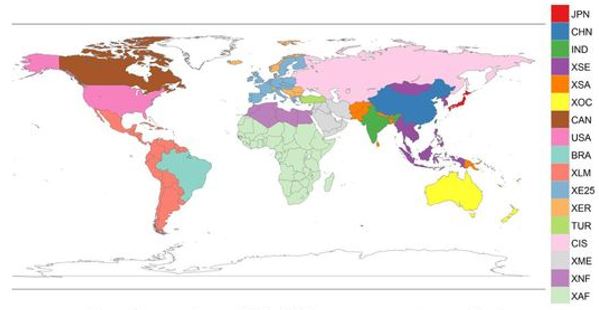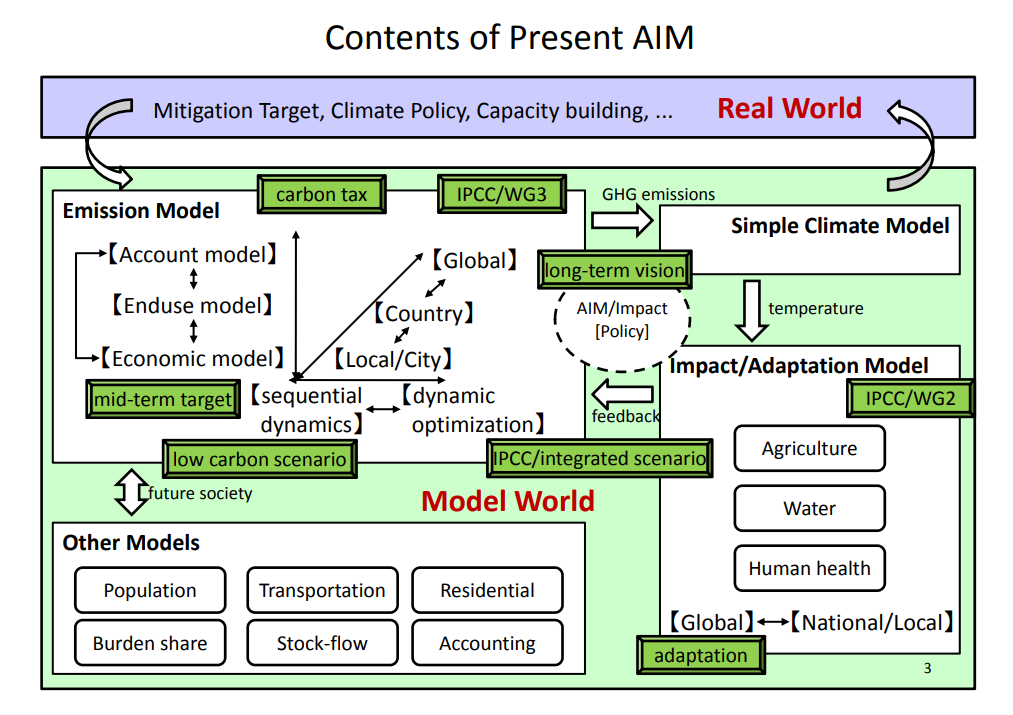Quoted from: https://www-iam.nies.go.jp/aim/about_us/index.html
The AIM comprises three main models - the greenhouse gas emission model (AIM/emission), the global climate change model (AIM/climate.), and the climate change impact model (AIM/impact). The AIM/emission model estimates greenhouse gas emissions and assesses policy options to reduce them. The AIM/climate model forecasts concentrations of greenhouse gases in the atmosphere and estimates the global mean temperature increase. The AIM/impact model estimates climate change impacts on natural environment and socio-economy of the Asian-Pacific region.
The research program has made major contributions to policy deliberations at the nations, regional and global levels. The AIM model has been used to provide global and regional emission scenarios and regional impact assessments to the IPCC. The AIM model has been evaluated at the Stanford Energy Modeling Forum for the international comparison of emission scenarios and impact assessments. Other uses have included contributions to Eco Asia (the Congress of Asian Ministers for the Environment), the Global Environmental Outlook Program of UNEP, the UN Global Modeling Forum, and the Asian-Pacific Network Program.


History
It is predicted that global climate change will have significant impacts on the society and economy of the Asian-Pacific region, and that the adoption of measures to tackle global climate change will force the region to carry a very large economic burden. Also, if the Asian-Pacific region fails to adopt such countermeasures, it has been estimated that its Greenhouse Gas emissions will increase to over one-half of total global emissions by the end of the next century.
In order to respond to such serious and long term threats, it is essential to establish communication and evaluation tools for policy makers and scientists in the region. Integrated assessment is one of the most effective tools to increase the interaction among these groups. Integrated assessment provides a convenient framework for combining knowledge from a wide range of disciplines. The Asian-Pacific Integrated Model (AIM) is a large scale computer simulation model developed to promote the integrated assessment process in the region
The main goal of this model is to assess policy options for stabilizing global climate, particularly in the Asian-Pacific region, from the two perspectives of reducing greenhouse gas emissions and avoiding the impacts of climate change.
The AIM model has several distinct characteristics. It:
- integrates emission, climate and impact models.
- prepares both country modules for detailed evaluatio at the state and national level and global modules to ensure consistency across individual modules.
- integrates bottom-up national modules with top-down global modules.
- is designed to assess alternative policies.
- contains a very detailed technology selection module to evaluate the effect of introducing advanced technologies.
- uses information from a detailed Geographic Information System to evaluate and represent the distribution of impacts at the local level.
- focuses on the Asian-Pacific region and is based on a collaborative network of international research institutes.
Although this model is being developed primarily to help respond to climate change problems, it can also be applied to other issues, such as local air pollution issues, acid rain problems, forest management policies and other energy, agricultural and water resource management problems.
The research project to develop AIM was started in 1990 by the National Institute for Environmental Studies in collaboration with Professor Matsuoka, currently emeritus professor of Kyoto University. After the feasibility study for one year, the full-fledged research started in 1991, and the major modules of the AIM model were completed in three years. In 1994, the project was expanded with an international collaborative program to jointly develop national models with leading research institutes in several Asian countries. These national models are then integrated with the regional and global models. This collaboration program will be extended for a further three years from 1997 and expanded to provide more detailed evaluations of a broader range of impacts and policy options.
The research program has already made major contributions at the national, regional and global level of policy deliberations. The AIM model was used to provide global and regional emission scenarios to the IPCC. The impact assessments generated by AIM were used by the IPCC impact working group for their regional evaluations. AIM team members also served as lead authors for IPCC reports. The AIM model was also used at the Stanford Energy Modeling Forum for the international comparison of emission scenarios and impact assessments. At the regional level, AIM has been adopted as an in-house model for the evaluation of alternative policies by Eco Asia, the Congress of Asian Ministers for the Environment. National governments have adopted AIM for the evaluation of policies such as carbon taxes, technology subsidies and changes in consumption behavior. Other uses have included contributions to the Global Environmental Outlook Program of UNEP, the UN Global Modeling Forum and the Asian-Pacific Network Program.
This report provides a brief overview of the results from each major group of modules within AIM. The three major models represent emission processes, climate change processes and the resulting impacts. The emission model contains several national modules and predicts the emission of several gases. The climate change model integrates many carbon cycle attributes and climatic phenomena. The impact model then examines several important impacts that result from interactions with the emission and climate change models.
This program of research has been funded by the Global Environmental Research Fund of the Environment Agency of Japan. This funding is greatly appreciated and has served to create an exciting international network of researchers and policymakers striving to improve the future well-being of people throughout the Asian-Pacific Region.
We appreciate the exchange and sharing of ideas with the international modeling community. We also appreciate Professor Paul Parker for his editorial assistance.











